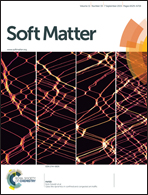Rheotaxis of spherical active particles near a planar wall
Abstract
For active particles the interplay between the self-generated hydrodynamic flow and an external shear flow, especially near bounding surfaces, can result in a rich behavior of the particles not easily foreseen from the consideration of the active and external driving mechanisms in isolation. For instance, under certain conditions, the particles exhibit “rheotaxis”, i.e., they align their direction of motion with the plane of shear spanned by the direction of the flow and the normal of the bounding surface and move with or against the flow. To date, studies of rheotaxis have focused on elongated particles (e.g., spermatozoa), for which rheotaxis can be understood intuitively in terms of a “weather vane” mechanism. Here we investigate the possibility that spherical active particles, for which the “weather vane” mechanism is excluded due to the symmetry of the shape, may nevertheless exhibit rheotaxis. Combining analytical and numerical calculations, we show that, for a broad class of spherical active particles, rheotactic behavior may emerge via a mechanism which involves “self-trapping” near a hard wall owing to the active propulsion of the particles, combined with their rotation, alignment, and “locking” of the direction of motion into the shear plane. In this state, the particles move solely up- or downstream at a steady height and orientation.


 Please wait while we load your content...
Please wait while we load your content...